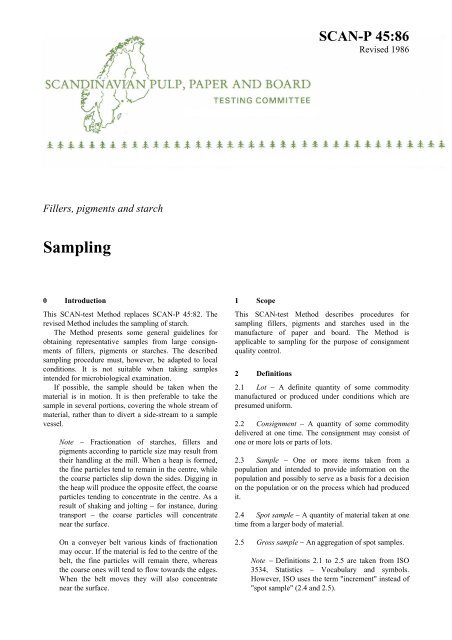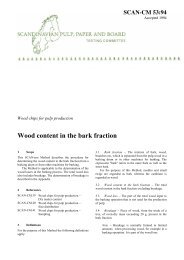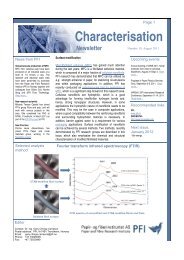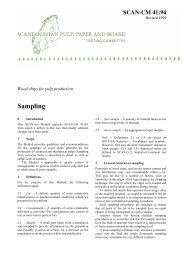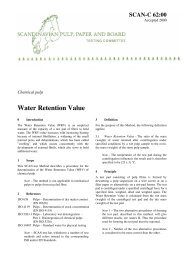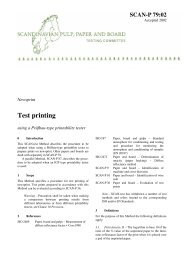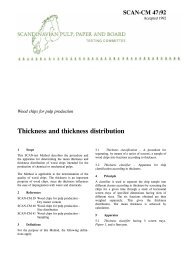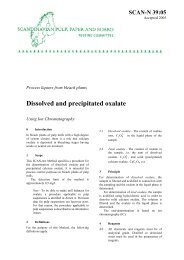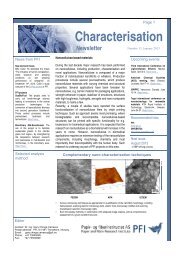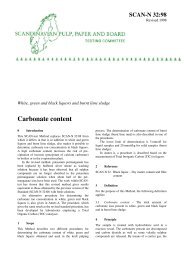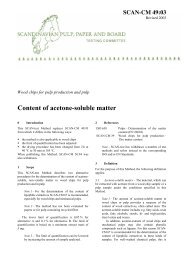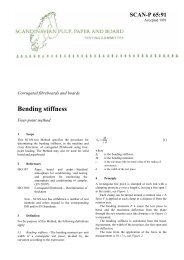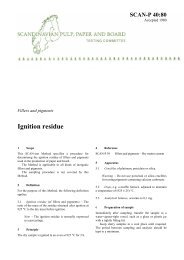SCAN-P 45:86 - PFI
SCAN-P 45:86 - PFI
SCAN-P 45:86 - PFI
- No tags were found...
You also want an ePaper? Increase the reach of your titles
YUMPU automatically turns print PDFs into web optimized ePapers that Google loves.
<strong>SCAN</strong>-P <strong>45</strong>:<strong>86</strong>Revised 19<strong>86</strong>Fillers, pigments and starchSampling0 IntroductionThis <strong>SCAN</strong>-test Method replaces <strong>SCAN</strong>-P <strong>45</strong>:82. Therevised Method includes the sampling of starch.The Method presents some general guidelines forobtaining representative samples from large consignmentsof fillers, pigments or starches. The describedsampling procedure must, however, be adapted to localconditions. It is not suitable when taking samplesintended for microbiological examination.If possible, the sample should be taken when thematerial is in motion. It is then preferable to take thesample in several portions, covering the whole stream ofmaterial, rather than to divert a side-stream to a samplevessel.Note − Fractionation of starches, fillers andpigments according to particle size may result fromtheir handling at the mill. When a heap is formed,the fine particles tend to remain in the centre, whilethe coarse particles slip down the sides. Digging inthe heap will produce the opposite effect, the coarseparticles tending to concentrate in the centre. As aresult of shaking and jolting − for instance, duringtransport − the coarse particles will concentratenear the surface.On a conveyer belt various kinds of fractionationmay occur. If the material is fed to the centre of thebelt, the fine particles will remain there, whereasthe coarse ones will tend to flow towards the edges.When the belt moves they will also concentratenear the surface.1 ScopeThis <strong>SCAN</strong>-test Method describes procedures forsampling fillers, pigments and starches used in themanufacture of paper and board. The Method isapplicable to sampling for the purpose of consignmentquality control.2 Definitions2.1 Lot − A definite quantity of some commoditymanufactured or produced under conditions which arepresumed uniform.2.2 Consignment − A quantity of some commoditydelivered at one time. The consignment may consist ofone or more lots or parts of lots.2.3 Sample − One or more items taken from apopulation and intended to provide information on thepopulation and possibly to serve as a basis for a decisionon the population or on the process which had producedit.2.4 Spot sample − A quantity of material taken at onetime from a larger body of material.2.5 Gross sample − An aggregation of spot samples.Note − Definitions 2.1 to 2.5 are taken from ISO3534, Statistics − Vocabulary and symbols.However, ISO uses the term "increment" instead of"spot sample" (2.4 and 2.5).
<strong>SCAN</strong>-P <strong>45</strong>:<strong>86</strong>Page 2Figure 1. Sampling spear (example, see alsosection 7)A. Outer tubeX. Detail of outer tubeA−B. Cut at A−BC. Inner tube3 Tools for various sampling situations3.1 Sampling from a conveyer belt, a sack or a barrel3.1.1 Plastic scoop or bucket.3.2 Sampling from a lorry or a large container3.2.1 Sampling spear consisting of two concentric metaltubes; an example is shown in Figure 1. The spear isoperated by first closing it by inserting the inner tubeinto the outer one, and then pushing the spear the desireddepth into the material to be sampled; the inner tube iswithdrawn and the outer one is filled by turning itcounter-clockwise.3.3 Sampling from slurries3.3.1 Sampling of fillers and pigments3.3.1.1 Sampling bottle, about 1 litre in volume and ofthe wide-necked type, mounted on the end of a shaft thatis long enough to reach the bottom of the slurrycontainer. The bottle is closed with a rubber stopperfastened to a string, which runs through eyes on theshaft, Figure 2. When the string is pulled the bottleopens.For sampling from very deep containers or tanks thekind of samplers intended for taking water samples fromlakes may be used. The principle of such a sampler isshown in Figure 3.Alternatively, a piece of plastic or glass tubing(length about 1,5 m, inner diameter about 10 mm) maybe used. Lower the tube into the container to the desiredsampling depth while keeping the upper end of the tubeclosed with a finger. Remove the finger and let the slurryrise in the tube. Close the tube again with the finger andraise it carefully. Empty the contents of the tube into asample container. This device, and similar ones having abulb, are used in essentially the same way as a laboratorypipette.3.3.2 Sampling of starches3.3.2.1 Plastic buckets
<strong>SCAN</strong>-P <strong>45</strong>:<strong>86</strong>Page 3Figure 2. Sampling bottle for slurries.3.4 Sample containers, at least as many as thenumber of gross samples (see sections 5.1 to 5.5), ofglass or plastic, about 1 litre in volume, with tightlyfitting lids.3.5 Protective clothing and respiration filter toprovide protection against the inhalation of dust.4 Inspection of the consignmentBefore sampling, judge whether the consignmentconsists of different lots. If the material is packed inbarrels or sacks, this can be deduced from productionnumbers or dates. The stock kept in storehouses or inpiles can consist of several lots of different colours andparticle sizes. Sample each such lot as though it were aseparate consignment.During the inspection, record the general appearanceof the consignment, whether any packages are defective,whether the consignment is contaminated, and any otherrelevant details.5 ProcedureIf a measure of the variation within the consignmentshall be obtained, keep all the spot samples separate.Otherwise, combine them to form one gross sample.Keep the samples in air-tight containers, marked foridentification.5.1 Sampling from a conveyer belt, for examplewhen unloading from a ship or a railway wagon. Use thescoop (3.1.1) and, if possible, move it through the wholestream of material, Figure 4. Otherwise, take spotsamples from both the middle and the margins of thestream. From a railway wagon take at least 5 such spotFigure 3 Sampling device for deep containers andtanks. The sampler is closed by allowinga weight to slide down along thesuspending line. The load hits thesampler and releases the hatches thatkeep it open.samples, and from a ship's hold at least 10. Each spotsample should contain at least 0,5 kg of sample.5.2 Sampling from a lorry, a ship's hold, etc.,including containers to be emptied with the aid of compressedair. Use the sampling spear (3.2.1) and take atleast 5 spot samples from different parts of the load.From a ship's hold, take at lest 10 spot samples. The totalamount taken should be at least 2,5 kg.
<strong>SCAN</strong>-P <strong>45</strong>:<strong>86</strong>Page <strong>45</strong>.3 Sampling from a pile or a large container.Divide the lot to be sampled into 4, 5 or 6 parts. Use thesampling spear (3.2.1) and insert it as far as possible intothe material. From each part of the lot take spot samples.The total amount collected should be at least 2,5 kg.5.4 Sampling from barrels or sacks. Select atrandom the appropriate number of units to be sampled,as indicated in the table:Total numberof unitsNumber of unitsto be sampled2 − 10 211 − 20 321 − 35 436 − 50 551 − 70 671 − 90 791 − 125 8126 − 160 9161 − 200 10If the consignment consists of more than 200 units,sample one additional unit for each group of 50additional units.Open all the units so selected and use the scoop(3.1.1) to take one representative spot sample from eachunit. If the sacks are very large, use the sampling spear(3.2.1). Take at least 0,5 kg from each unit; the totalamount collected shall be at least 2,5 kg.Note − Gross samples of starch should preferablybe subdivided so that only 0,5 kg will be sent to thelaboratory for analysis.5.5 Sampling from slurries5.5.1 Fillers and pigments. The sample should preferablybe taken when the slurry is in motion − for example,when it is being unloaded. Use a bucket (3.1.1) and takeat least 5 spot samples at equal time intervals duringunloading. For sampling, from a large container or atank, use one of the sampling devices described insection 3.3 and take spot samples from 5 different,evenly spaced, levels. The total amount of sample takenshould weigh at least 2,5 kg, air-dry basis.6 ReportThe sampling report shall include all the informationrequired to identify the samples and to ensure theirproper handling. State the time and place for thesampling.Figure 4. Sampling from conveyer belts.The report shall refer to this <strong>SCAN</strong>-test Method andinclude information concerning the following:(a) damaged units or containers;(b) visible contamination;(c) variation in colour;(d) anomalous appearance, presence of sediments, etc.;(e) any other information that may have a bearing onthe final results, such as any deviation from theprocedure described in this Method.7 Additional informationThe table in section 5.4 is identical with that inISO 1512:1974, Paints and varnishes − Sampling.The sampling spear (3.2.1) is that described inMerkblatt V /27, published by Verein der Zellstoff- undPapier-Chemiker und Ingenieure, Darmstadt 1975,whose cooperation is gratefully acknowledged.5.5.2 Starch. Sample only from slurries in motion. Take0,5 kg of sample. In other respects, follow theinstructions in section 5.5.1.<strong>SCAN</strong>-test Methods are issued and recommended byKCL, <strong>PFI</strong> and STFI-Packforsk for the pulp, paper andboard industries in Finland, Norway and Sweden.Distribution: Secretariat, Scandinavian Pulp, Paperand Board Testing Committee, Box 5604,SE-114 <strong>86</strong> Stockholm, Sweden.


